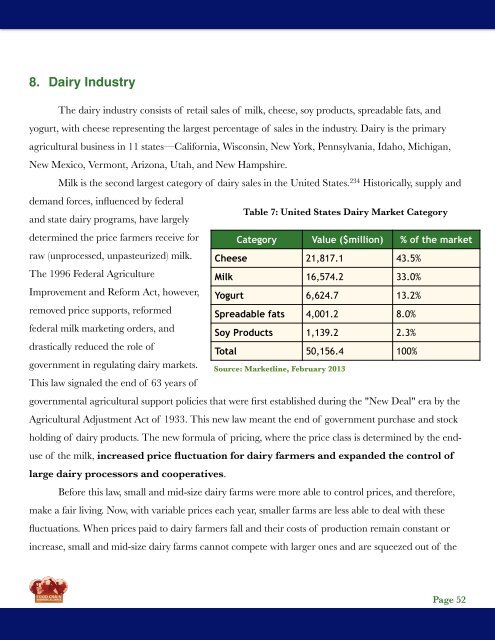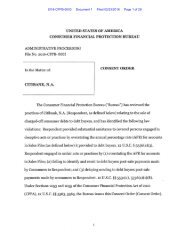Walmart-at-the-Crossroads-FINAL-06.04.15
Walmart-at-the-Crossroads-FINAL-06.04.15
Walmart-at-the-Crossroads-FINAL-06.04.15
Create successful ePaper yourself
Turn your PDF publications into a flip-book with our unique Google optimized e-Paper software.
8. Dairy Industry<br />
The dairy industry consists of retail sales of milk, cheese, soy products, spreadable f<strong>at</strong>s, and<br />
yogurt, with cheese representing <strong>the</strong> largest percentage of sales in <strong>the</strong> industry. Dairy is <strong>the</strong> primary<br />
agricultural business in 11 st<strong>at</strong>es—California, Wisconsin, New York, Pennsylvania, Idaho, Michigan,<br />
New Mexico, Vermont, Arizona, Utah, and New Hampshire.<br />
Milk is <strong>the</strong> second largest c<strong>at</strong>egory of dairy sales in <strong>the</strong> United St<strong>at</strong>es.<br />
234<br />
Historically, supply and<br />
demand forces, influenced by federal<br />
and st<strong>at</strong>e dairy programs, have largely<br />
determined <strong>the</strong> price farmers receive for<br />
raw (unprocessed, unpasteurized) milk.<br />
The 1996 Federal Agriculture<br />
Improvement and Reform Act, however,<br />
removed price supports, reformed<br />
federal milk marketing orders, and<br />
drastically reduced <strong>the</strong> role of<br />
government in regul<strong>at</strong>ing dairy markets.<br />
This law signaled <strong>the</strong> end of 63 years of<br />
governmental agricultural support policies th<strong>at</strong> were first established during <strong>the</strong> "New Deal" era by <strong>the</strong><br />
Agricultural Adjustment Act of 1933. This new law meant <strong>the</strong> end of government purchase and stock<br />
holding of dairy products. The new formula of pricing, where <strong>the</strong> price class is determined by <strong>the</strong> enduse<br />
of <strong>the</strong> milk, increased price fluctu<strong>at</strong>ion for dairy farmers and expanded <strong>the</strong> control of<br />
large dairy processors and cooper<strong>at</strong>ives.<br />
Table 7: United St<strong>at</strong>es Dairy Market C<strong>at</strong>egory<br />
C<strong>at</strong>egory Value ($million) % of <strong>the</strong> market<br />
Cheese 21,817.1 43.5%<br />
Milk 16,574.2 33.0%<br />
Yogurt 6,624.7 13.2%<br />
Spreadable f<strong>at</strong>s 4,001.2 8.0%<br />
Soy Products 1,139.2 2.3%<br />
Total 50,156.4 100%<br />
Source: Marketline, February 2013<br />
Before this law, small and mid-size dairy farms were more able to control prices, and <strong>the</strong>refore,<br />
make a fair living. Now, with variable prices each year, smaller farms are less able to deal with <strong>the</strong>se<br />
fluctu<strong>at</strong>ions. When prices paid to dairy farmers fall and <strong>the</strong>ir costs of production remain constant or<br />
increase, small and mid-size dairy farms cannot compete with larger ones and are squeezed out of <strong>the</strong><br />
Page !52



